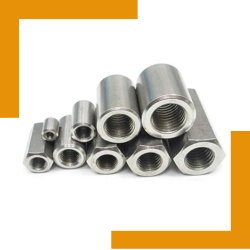Why is it Significant to use Rebar Couplers to build your house?
It was long believed that the number of long bars required may be reduced by connecting reinforcing bars using mechanical couplers. Couplers are becoming a more common tool for engineers and builders to increase efficiency, streamline design elements, and expedite the building process.
Skyscraper and other large-scale construction projects benefit greatly from the inexpensive and effective way that rebar couplers unite bars with large diameters. Rebar couplers are also frequently referred to as mechanical splices. The rebar coupler is a crucial tool in the construction process that is used to build towers, bridges, buildings, dams, and many other structures.

Using a coupler in reinforcement is crucial for a number of reasons, some of which are as follows:
A rebar coupler can improve the structural stability.
This makes it much easier to calculate the lapping length.
Because the rebar coupler does not waste bars, employing it instead of lapping results in a larger bar usage.
Simple and fundamental methods are employed to investigate the link.
This expedites the procedure by enabling a speedy installation.
Among all the joint reinforcing techniques, it offers the best value for the money.
When it comes to continuity, the load path is accurate.
It appears like the load is being effectively handled.
It is not to blame for traffic congestion on the roads.
For the rebar coupler in india, a very high degree of quality control and monitoring has been used.
Lowering the Stress of Fracture in Concrete Joints: A specific purpose exists for rebar couplers.
“Rebar couplers” are mechanical connectors used to fasten reinforcement bars in concrete joints. They eliminate the need for the laborious process of “lap splicing,” which entails tying and overlapping bars. They succeeded in achieving this by refining an effective and dependable connection technique. This seamless connection allows the reinforcing bars to remain continuous, which distributes the load evenly throughout the structure.
Increasing the Efficiency of the Load Transfer
It is essential to ensure that the load is distributed across the concrete components in order to preserve the structural integrity. By forming a continuous channel for stress and distribution, rebar couplers enhance the efficiency of the load transfer process. You can state your requirements to the Rebar coupler Manufacturer.
Rebar couplers could be able to assist you in overcoming construction-related challenges.
Rebar couplers have a number of practical advantages while construction. Because they simplify assembly and cut down on installation time, they save money and shorten building cycles. Furthermore, they function well in areas where typical lap splicing would be problematic or impossible because to limited space or intricate geometry.
Regulatory compliance and quality control
Ensuring the safety and dependability of concrete buildings requires strict adherence to industry standards and regulations. Rebar couplers must fulfill specific requirements in order to guarantee their proper operation under varying conditions. By employing certified rebar couplers, engineers and contractors can be guaranteed that their projects will comply with all building codes and remain structurally sound over time.
Resistance to corrosion and long-term durability
The purpose of the various materials and coatings used to make rebar couplers is to make them resistant to weathering and corrosion. Possessing these attributes significantly lengthens the concrete joints’ lifespan, which lowers maintenance requirements and lengthens the building’s lifespan.
High-rise projects often use rebar couplers for core walls, beams, and columns. This is due to the fact that high-rise buildings must prioritize both structural integrity and efficiency.
In infrastructure projects like highways, tunnels, and bridges, as per Rebar coupler Manufacturers, rebar couplers are used to ensure that crucial load-bearing components have strong connections.
In commercial and industrial buildings like as factories and warehouses, couplers are often used to reinforce massive and complex concrete parts.
Future modifications and emerging patterns
The goal of research is to produce rebar coupler materials that are stronger and more resistant to corrosion, which will lengthen their lifespan.
Couplers are being included into prefabricated pieces more frequently, which simplifies assembly and reduces the amount of work required on-site. Prefabrication is the term for this technique.
Couplers could be a component of “smart construction,” a recent development in the building industry that use sensors to monitor load distribution and building condition.
Lastly, every concrete connection that needs to be held together to prevent collapse needs rebar couplers. By providing a dependable and efficient way to fasten reinforcement bars, concrete buildings can be made more stable and have better load transfer efficiency. Rebar couplers are now a necessary equipment for contemporary engineering projects due to the constantly changing nature of the building processes.